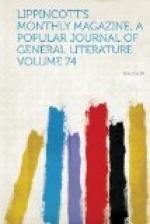But I must endeavor to give the reader an idea of the outward appearance of my acquaintance. He wore a long horse-man’s cloak of dark-brown cloth, with a deep fur collar, which hung loosely from his shoulders, and being entirely open in front displayed a scarlet waistcoat ornamented with silver buttons beneath it, and thighs clad in black velveteen breeches. His lower legs were cased in gaiters of a very peculiar make. They were of light-brown colored leather, so made as to present an altogether creaseless surface, and yet fitted to the leg by numerous straps and buckles so closely that they exhibited the handsome and well-formed limb beneath them almost as perfectly as a silk stocking could have done. Below the ankle they closely clasped a boot which was armed with a very severe spur. The rider wore a high conical black felt hat—such a hat as is called, significently enough, “un cappello de brigante,” a brigand’s hat. It had, moreover, a scarlet ribbon around it, which added much to the brigand-like picturesqueness of the figure. Yet my friend was by no means a brigand, for all that. But the portion of his accoutrement which was perhaps the most remarkable has not been mentioned yet. While managing his reins, snaffle and curb, with excellent ease in his left hand, his right held—not a whip or stick of any sort, but—a lance like a rod, some seven or eight feet long, and armed at the end with a short iron spike. This spike rested on the toe of his boot as he rode—an attitude which, resembling that of a cavalier entering the tournament lists, gave to the rod in question all the appearance of a knightly lance. Yet there is in the recollection or the imagination of most people another figure whom on the whole the rider in the Piazza della Bocca della Verita would have been more likely to recall to their minds—the mounted Arab of the desert. I hardly know why it should be so. But there was a something about the general outline of the figure draped in its cloak, and in the way in which the long slight lance was held, that had an unmistakably Eastern look about it. There was a certain air of dignity too about my friend which contributed to his Arab-like appearance. Yet it was not exactly the dignity of the grave and impassible Eastern man. It was a mixture of dignity and jauntiness. There was a certain air of self-consciousness about the man




